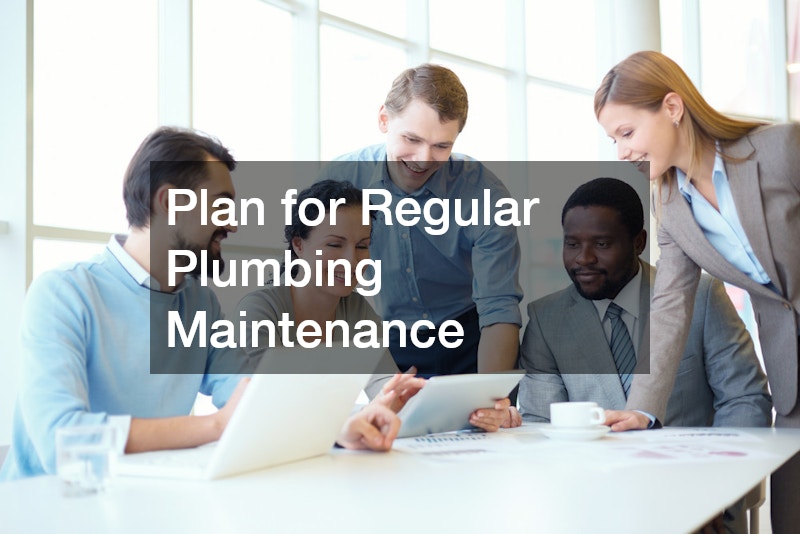Owning a commercial property comes with both benefits and responsibilities. While business owners and property investors appreciate the recurring income, tax advantages, and long-term appreciation that commercial real estate often delivers, they also face the reality that every property eventually needs repairs, upgrades, and ongoing maintenance. These costs can be predictable or unexpected, minor or significant—and without careful planning, they can catch even experienced owners off guard.
Budgeting for commercial property repairs isn’t simply about setting aside money. It involves forecasting, prioritizing, evaluating risks, understanding building systems, and preparing for long-term capital improvements. Every system—from electrical and commercial plumbing to roofing and HVAC—has its own lifespan and maintenance requirements. As a property owner, aligning your repair budget with these cycles helps you protect your investment and maintain building safety, value, and performance.
This comprehensive guide explains how to effectively budget for commercial repairs, anticipate expenses, strengthen financial planning, reduce emergency costs, and maintain your property with confidence. Whether you own a retail space, office building, warehouse, multi-suite complex, or mixed-use property, these budgeting strategies will help you stay prepared, compliant, and financially stable all year long.

Understand the Lifespan of Your Building Systems
Every commercial property contains a variety of systems that age at different rates. One of the first steps in budgeting for commercial repairs is understanding the average lifespan and cost of maintaining these systems. This helps you anticipate when major expenses are likely to occur.
Typical examples include:
- HVAC units, which often last 10–20 years
- Commercial roofing materials, which vary between 15–40 years
- Plumbing systems that may need updates every 20–50 years
- Windows and doors that require replacement every 20–30 years
- Electrical panels, which may need upgrades every 25–40 years
Having a detailed inventory of each major system and its projected lifespan allows you to map out upcoming expenses. This prevents surprises and helps you plan financially for upcoming capital improvements.
Taking inventory also helps you identify outdated or failing equipment that may require immediate attention. A systematic review each year provides clarity on where your money will likely go during upcoming maintenance cycles.
Perform Routine Property Inspections
Regular inspections are essential for catching issues while they are still small and affordable. A neglected commercial property can quickly become an expensive one, especially when minor issues turn into major problems.
The frequency of inspections varies depending on the building’s age, size, and usage, but generally, each system should be inspected at least once a year. Some systems—like HVAC and plumbing—benefit from twice-yearly evaluations.
During inspections, you should pay particular attention to:
- Roof conditions, including flashing, seams, and drainage
- Exterior walls and siding
- Windows, caulking, and seals
- Electrical components, panels, and visible wiring
- Plumbing connections and drains
- Structural components
- Common areas exposed to heavy foot traffic
- Parking areas, curbs, and sidewalks
If an inspection reveals warning signs of deterioration, such as water stains, leaks, cracks, or mold, immediate action prevents more expensive repairs later.
By planning inspections into your yearly budget, you create predictable and manageable expenses that protect your building and reduce emergency repair costs.

Create a Dedicated Commercial Repair Fund
Just as homeowners benefit from emergency funds, commercial property owners should maintain a dedicated repair fund. This fund protects your cash flow when unexpected issues arise and prevents the need for high-interest loans or disruptive financial decisions.
To determine how much to contribute to your fund each year, consider:
- The age of your building
- The climate and environmental exposure
- Property usage type (e.g., retail vs. warehouse)
- Tenant density and daily foot traffic
- Past repair patterns
- Contractor evaluations and predictions
A commonly recommended guideline is to allocate 1–4% of your property’s value annually for repairs and maintenance. Newer buildings may require less, while older structures may need significantly more.
Keeping these funds separate from operating capital ensures repairs are financially manageable and never compromise your business’s daily cash flow.
Break Repairs Into Categories for Better Budgeting
Not all commercial repairs are created equal. Categorizing your repair needs helps you prioritize spending and maintain better control over your budget. Typical categories include:
1. Preventive Maintenance
Scheduled tasks are designed to prevent problems before they occur.
Examples: filter changes, lubrication, cleaning, tightening, and inspections.
2. Corrective Repairs
Repairs are required due to normal wear or gradual deterioration.
Examples: replacing broken tiles, patching walls, repairing lighting.
3. Emergency Repairs
Sudden, unpredictable issues requiring immediate attention.
Examples: leaks, electrical failures, burst pipes, roof blow-offs.
4. Capital Improvements
Long-term upgrades are intended to enhance the property’s value or lifespan.
Examples: new roofing materials, structural updates, and window replacements.
Dividing repairs into categories ensures you budget appropriately and sets realistic expectations for yearly expenses.

Prioritize High-Value Repairs First
Some repairs are more critical than others. When creating your annual repair budget, prioritize items that affect:
- Tenant safety
- Building code compliance
- Structural stability
- Fire prevention
- Energy efficiency
- Insurance requirements
Neglecting these areas can result in costly fines, legal liability, or emergency repairs that far exceed the cost of routine maintenance. Prioritization keeps your property operating safely, efficiently, and profitably.
Estimate Costs Based on Professional Evaluations
Commercial repairs often require professional experience to determine accurate cost estimates. For example, evaluating plumbing issues or assessing roof wear isn’t something most property owners can do accurately on their own.
To create a realistic budget, request quotes or evaluations for the major systems you expect to maintain during the year. Contractors specializing in specific services can provide accurate pricing so you allocate the correct amount for repairs.
Some owners choose to maintain a relationship with trusted service providers who help track building performance and costs over time. This creates consistency and helps you anticipate large expenses as the property ages.

Plan for Regular Plumbing Maintenance
Plumbing issues can escalate quickly in commercial buildings, especially those with high occupancy or heavy daily usage. Routine maintenance prevents clogs, leaks, corrosion, and water damage.
Scheduling yearly evaluations with a commercial plumber helps keep your systems performing reliably. They can identify issues early and recommend appropriate repairs or replacements.
If major sewer problems arise, you may need specialized assistance from a sewer repair company to restore functionality and prevent environmental hazards. Sewer issues can lead to costly repairs if not addressed promptly.
Budgeting for plumbing care ensures your building maintains proper sanitation, water pressure, and code compliance.
Evaluate Drainage, Waste, and Trash Management Systems
Improper waste management can lead to sanitation issues, property damage, pest infestations, and tenant complaints. Commercial buildings often produce large volumes of waste that require efficient systems.
Routine evaluations help identify inefficiencies in your trash and waste handling procedures. For example, coordinating with a commercial waste removal service ensures that trash pickup occurs on a schedule that prevents overflow and sanitation problems.
Some buildings benefit from automated equipment, including compacting solutions. Installing or maintaining a commercial trash compactor reduces waste volume, lowers removal costs, and improves cleanliness around the property.
Accounting for waste-related systems in your budgeting helps prevent costly issues caused by neglect or inadequate capacity.
Protect Your Exterior With Siding, Fencing, and Landscaping Budgets
Your exterior demonstrates the first impression of your property and significantly influences tenant satisfaction and property value. Budgeting for exterior upkeep prevents deterioration and maintains a professional appearance.
When siding becomes damaged or weather-worn, hiring a commercial wood fencing company or exterior specialist may be necessary for repairs or updates. Similarly, older siding materials may require a professional siding installation to maintain insulation and protection from the elements.
Landscaping maintenance is also critical. Property owners sometimes rely on contractors to manage trimming, mowing, and seasonal cleanup. Aesthetic upkeep helps maintain a safe, professional property appearance that tenants appreciate.
Prioritizing exterior care ensures your property remains visually appealing and structurally sound year-round.
Budget for Roofing Repairs and Maintenance
Commercial roofs vary widely in materials and durability, but all require consistent care. Roof leaks can cause significant damage, including ruined flooring, mold growth, damaged inventory, and tenant displacement.
Scheduling regular inspections with professionals offering commercial roofing services helps identify vulnerabilities early. They can patch small issues, reseal seams, improve drainage, and recommend cost-effective maintenance that delays full replacement.
Even well-built roofs require scheduled upkeep. Many property owners create a multi-year roof budget that includes cleaning, patching, and eventual replacement based on the roof’s expected lifespan.
Keeping your roof healthy protects your building and reduces long-term repair costs.
Account for Window, Door, and Entryway Repairs
Windows and doors influence energy efficiency, security, and building performance. Over time, older frames may warp, seals may fail, and glass may degrade.
If your windows are outdated or no longer energy-efficient, coordinating with commercial window installers helps lower heating and cooling costs, improve light quality, and reduce exterior noise.
Entry doors, especially in high-traffic areas, may require periodic replacement, hardware upgrades, or improved access control systems. These updates improve tenant safety and enhance building functionality.
By budgeting for window and door improvements, you protect interior spaces from temperature fluctuations, water intrusion, and unnecessary wear.
Remember to Budget for Elevators and Mechanical Equipment
Buildings with elevators must carefully plan for inspections, repairs, and maintenance. Mechanical equipment requires regular lubrication, alignment, testing, and safety checks.
Budgeting for ongoing work from an elevator commercial service ensures compliance with safety regulations and helps prevent costly breakdowns. Elevator failures can disrupt tenant operations, create accessibility issues, and result in liability risks.
Mechanical equipment—boilers, chillers, generators, and HVAC systems—also need consistent evaluation. Their maintenance must be included in your repair budget to avoid catastrophic failures.
Failing to maintain mechanical systems can significantly increase energy usage and lead to much larger repair expenses down the line.
Forecast Long-Term Capital Improvements
Capital improvements differ from routine repairs. They involve major upgrades that extend the lifespan of the property or significantly enhance value.
Examples include:
- Replacing roofing materials
- Upgrading HVAC systems
- Installing new windows and doors
- Reconfiguring interior layouts
- Updating electrical systems
- Adding solar panels
- Enhancing building accessibility
Capital improvements can cost tens or hundreds of thousands of dollars. Building owners typically create a 5-, 10-, or 20-year capital improvement plan to prepare financially.
Including long-term planning in your budgeting helps you avoid shock expenses and makes major upgrades manageable over time.
Address Parking Lot, Sidewalk, and Pavement Repairs
Exterior surfaces experience heavy daily use and weather exposure. Cracks, potholes, and uneven concrete can lead to safety hazards and liability risks.
Budgeting for pavement maintenance includes:
- Crack sealing
- Repainting parking lines
- Filling potholes
- Replacing broken concrete
- Installing better drainage
- Enhancing lighting for nighttime safety
These expenses not only improve appearance but also reduce the risk of slip-and-fall incidents.
Regular upkeep of outdoor surfaces prevents costly future damage caused by neglected pavement deterioration.
Prepare for Emergency Repairs and Tenant Needs
Even with preventative maintenance, unexpected issues occur. These emergencies may include:
- Burst pipes
- Power outages
- Storm damage
- Roof leaks
- Broken glass
- Structural problems
Your emergency repair fund should cover issues that require immediate attention. This flexibility prevents disruptions to tenant operations and demonstrates that you are a responsive, reliable property owner.
Scheduling backup services for emergencies—such as plumbing, electrical, and structural repair providers—ensures you’re prepared when sudden issues arise.
Incorporate Commercial Storage and Operational Costs
Some properties require additional space to store equipment, supplies, or seasonal items. Allocating funds for commercial storage ensures you have secure, climate-controlled areas to maintain building materials or temporarily relocate items during repairs.
Storage budgeting also helps you avoid clutter, maintain safety, and keep property maintenance tools organized.
Operational planning is often overlooked but extremely helpful for maintaining smooth property management.
Strengthen Financial Planning with Professional Services
Working with commercial property specialists helps you create accurate budgets and anticipate upcoming expenses. You may want to collaborate with:
- Property managers
- Accountants
- Contractors
- Building inspectors
- Facility management consultants
These experts offer valuable insights into repair timing, materials, and long-term costs. Their guidance helps you avoid overspending or ignoring critical repairs.
Some owners benefit from yearly financial reviews that adjust repair budgets based on the building’s age, condition, and known vulnerabilities.
Create a Yearly Maintenance Calendar
Your repair budget is far more effective when tied to a calendar. Create a schedule detailing when to:
- Inspect systems
- Replace filters
- Check roofs
- Evaluate plumbing
- Update equipment
- Inspect windows
- Test safety systems
- Complete landscaping
This organized schedule establishes predictable cycles and helps prevent unexpected costs.
You should also schedule time for tenant feedback. Regular communication helps tenants report issues before they become emergencies.
Budgeting for commercial property repairs is one of the most important responsibilities for any property owner. With strategic planning, regular inspections, accurate cost estimations, and clear spending priorities, you can protect your investment, maintain tenant satisfaction, and stay financially prepared for both routine maintenance and unexpected issues. A well-structured repair budget gives you peace of mind, supports long-term property health, and ensures your building remains safe, modern, and competitive in the commercial real estate market.




